Canada Inland Spousal Sponsorship Timeline: Your Complete 2025 Guide
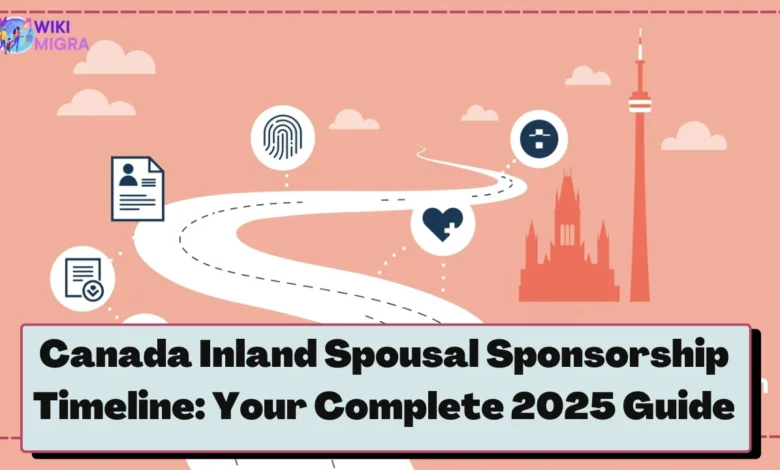
Table of Contents
You’re embarking on one of the most significant journeys in your life – bringing your loved one to live permanently with you in Canada, or formalizing their status if they’re already here. You’ve chosen the inland spousal sponsorship route, likely because your spouse or common-law partner is already in Canada with you. Now, the big question looms: how long will the Canada inland spousal sponsorship timeline actually be?
Let’s address it head-on. Based on the latest information from Immigration, Refugees and Citizenship Canada (IRCC), the average processing time for inland spousal sponsorship applications currently hovers around 8-12 months (always check the official tool for the most current estimate!). However – and this is crucial – this is just an average. Your individual inland spousal sponsorship processing time can vary significantly based on numerous factors.
This guide is designed to be your comprehensive resource. We’ll dissect the length of the inland spousal sponsorship process stage by stage, explore the key elements that can influence your specific wait time inland spousal sponsorship, and provide actionable tips to navigate the system effectively. Understanding the distinction between inland and outland sponsorship is also key, as it impacts certain aspects like work permit eligibility during processing. Let’s break down the journey ahead.
Quick Answer / Summary Box
- Estimated Total Time: Approximately 8-12 months (Average as of late 2024/early 2025 estimates – subject to change. Source: IRCC).
- Key Stages: Application Preparation & Submission -> Acknowledgment of Receipt (AOR) -> Biometrics Request & Completion -> Medical Examination Request & Completion -> Eligibility Review (Sponsor & Applicant) & Background Checks -> Approval in Principle (AIP) -> Open Work Permit (OWP) Processing (if applicable) -> Final Decision & COPR/Landing.
- Main Influencing Factors: Quality and completeness of your application, current IRCC processing volumes and potential backlogs, the complexity of your specific case (e.g., previous immigration history, dependents), how quickly you respond to IRCC requests.
- The Official Source: Always consult the official IRCC Processing Time Tool for the latest estimates specific to “Spouse or common-law partner living inside Canada”.
Understanding the Difference: Inland vs. Outland Sponsorship Timelines
Before diving into the specifics of the inland partner sponsorship timeline Canada, it’s important to briefly touch upon the difference between inland and outland processing.
- Inland Sponsorship: This stream is for situations where the sponsored spouse or common-law partner is already living in Canada with the sponsor, usually under some form of temporary status (like a visitor visa, study permit, or work permit). A key advantage of the inland process is the potential eligibility for an Open Work Permit (OWP) while the application is processing, allowing the applicant to work for any employer in Canada.
- Outland Sponsorship: This stream is technically for applicants living outside Canada. However, applicants physically inside Canada can sometimes opt for outland processing (e.g., if they don’t intend to stay in Canada for the entire processing duration). Outland processing doesn’t typically offer eligibility for the specific spousal OWP linked to the PR application itself (though the applicant might be eligible for other types of work permits).
While IRCC aims for similar overall processing times for both streams, the experience differs, particularly regarding the OWP. Historically, outland processing was sometimes faster, but recent trends show IRCC working to harmonize the Canada inland sponsorship duration with its outland counterpart. This guide focuses specifically on the inland spouse visa processing time and its associated steps.
You may be interested in: Navigate the Pitfalls: A Clear Guide to Inland vs Outland Spousal Sponsorship 2025
The Official Source: IRCC Processing Time Tool
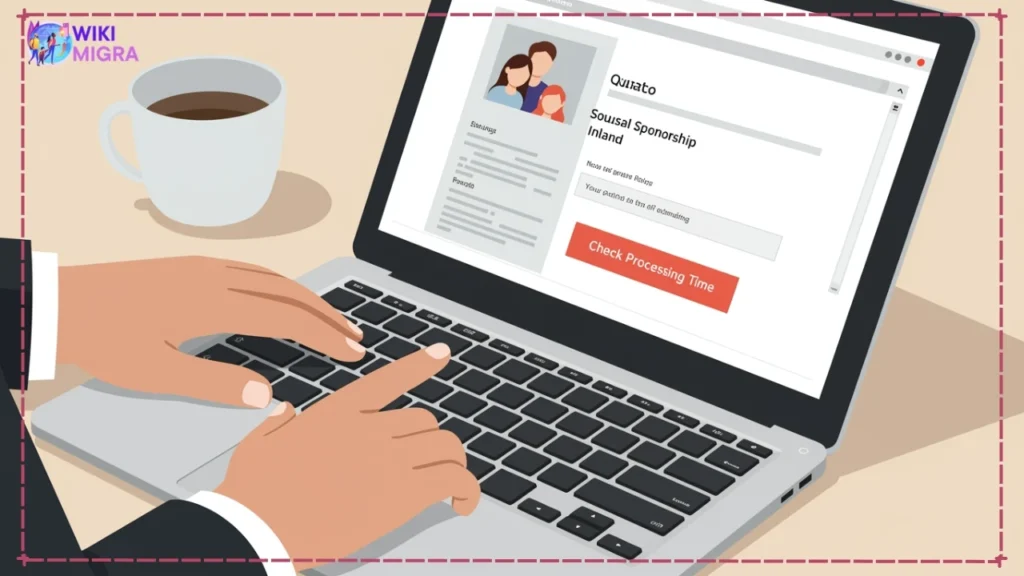
The most reliable starting point for estimating your how long inland spousal sponsorship Canada will take is the official IRCC Processing Time Tool.
- What it is: This online tool provides estimates based on the average time it took to process most (80%) completed applications in the recent past.
- How to Use It Correctly:
- Go to the IRCC Processing Time Tool website.
- Select the application type: “Permanent Residence.”
- Choose the specific permanent residence category: “Family Sponsorship.”
- Specify further: “Spouse or common-law partner living inside Canada.”
- Important Caveat: The time shown is an estimate, not a guarantee. It reflects historical data and doesn’t predict your exact timeline. Factors like application backlogs, individual case complexity, and even the specific visa office involved can influence the actual wait time inland spousal sponsorship. Use it as a benchmark, but prepare for potential variations.
Stage-by-Stage Breakdown of the Inland Sponsorship Timeline
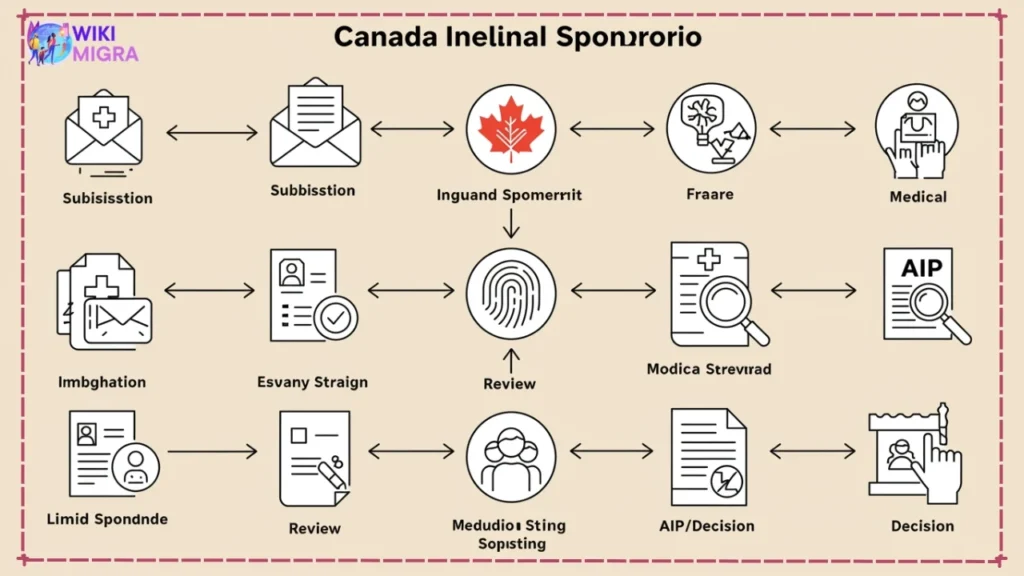
Understanding each phase of the process can help manage expectations and highlight where you have the most control. Here’s a typical flow for the Canada inland spousal sponsorship timeline:
Stage 1: Application Preparation & Submission
- What it involves: This is the crucial foundation-laying stage. It involves meticulously gathering all required documents (proof of identity, status documents, police certificates, relationship evidence – photos, chat logs, joint bank accounts, leases, etc.) and accurately completing numerous IRCC forms (for both the sponsor and the applicant). Since October 2022, most applications must be submitted online via the Permanent Residence Portal.
- Timeline Impact: While there’s no set processing time by IRCC for this stage (it depends on how quickly you prepare), its thoroughness is critical. A complete, well-organized application with strong relationship evidence significantly reduces the chances of delays later due to requests for additional documents (ADRs) or concerns about relationship genuineness. Rushing this stage is a common mistake that can significantly extend the overall inland spousal sponsorship processing time. Expect this stage to take anywhere from a few weeks to several months, depending on your organizational skills and the complexity of gathering documents (especially police certificates from multiple countries).
Stage 2: Submission to Acknowledgment of Receipt (AOR)
- What AOR means: This is the first official confirmation from IRCC that they have received your application package and deemed it complete enough to create a file and begin processing. It usually includes your application number (e.g., F000…). Receiving the AOR is a significant milestone.
- Estimated Time: Historically, this took 1-3 months after submission. With the shift to mandatory online applications, this initial phase is often faster, sometimes within weeks. However, fluctuations in intake volume can still cause delays.
- Factors Affecting This: Primarily IRCC’s initial intake processing capacity. An incomplete application (missing signatures, documents, incorrect fees) will be returned without an AOR, causing significant delays as you’ll need to resubmit.
Stage 3: Biometrics Request & Completion
- When it’s typically requested: Usually, shortly after you receive your AOR, the principal applicant (the person being sponsored) will receive a Biometrics Instruction Letter (BIL).
- What it involves: The applicant needs to book an appointment at a designated Service Canada location (if inside Canada) or a Visa Application Centre (VAC) abroad (if they happen to be travelling) to provide fingerprints and a photograph.
- Timeline Impact: IRCC issues the BIL relatively quickly post-AOR. The delay here depends on how quickly the applicant can secure an appointment (availability varies by location) and attend it. The applicant typically has 30 days from the date of the BIL to provide their biometrics. The data is then electronically transmitted to IRCC. This stage usually adds a few weeks to the overall Canadian inland spouse visa processing time, factoring in request issuance, appointment booking, and completion.
Stage 4: Medical Examination Request & Completion
- When it’s requested: This can vary. Sometimes IRCC requests the Immigration Medical Exam (IME) shortly after AOR, potentially around the same time as biometrics. Other times, it might come later in the process. Applicants can also choose to do an upfront medical exam before submitting the application, including the proof of completion with their package. This can potentially save time later.
- What it involves: The applicant must schedule an appointment with an IRCC-approved Panel Physician. The physician performs a standard medical assessment and sends the results directly to IRCC.
- Timeline Impact: If not done upfront, IRCC will send Medical Examination Instructions. Similar to biometrics, the applicant needs to book and attend the appointment. Panel physicians have their own processing times for submitting results. Doing the medical upfront can shave off the request/instruction time later. If requested during processing, this stage adds several weeks (request issuance + appointment + physician submission time) to the inland common-law sponsorship timeline.
Stage 5: Eligibility Review (Sponsor & Applicant) & Background Checks
- The Core Processing Stage: This is often the longest and least transparent part of the Canada inland spousal sponsorship timeline. IRCC officers meticulously review the entire application.
- What IRCC Checks:
- Sponsor Eligibility: Verifying the sponsor meets requirements (Canadian citizen/PR, residing in Canada, not receiving social assistance for reasons other than disability, meets minimum income if sponsoring dependent children who have dependent children of their own, etc.).
- Applicant Eligibility: Primarily focusing on the genuineness of the relationship. Officers assess the submitted evidence to ensure the marriage or common-law partnership wasn’t entered into primarily for immigration purposes. They also check the applicant’s previous immigration history.
- Admissibility (Applicant): Background checks are conducted to ensure the applicant is not inadmissible to Canada on grounds of security, criminality, health (though typically manageable unless it poses excessive demand or danger), or misrepresentation. These checks involve various Canadian (e.g., RCMP, CSIS) and potentially international databases, depending on the applicant’s history and citizenship.
- Estimated Time: Highly variable, often 4-8 months or more, forming the bulk of the length of inland spousal sponsorship process. This stage is heavily influenced by case complexity and IRCC workload. Background checks, especially security screening involving international partners, can sometimes add significant, unpredictable time.
Stage 6: Approval in Principle (AIP)
- What AIP signifies: This is a crucial milestone for inland applicants. AIP means the reviewing officer has determined that the sponsor appears eligible to sponsor and the applicant appears to meet the eligibility requirements of the spousal/common-law class (primarily, the relationship is deemed genuine and the applicant seems admissible pending final checks).
- Key Inland Benefit: Receiving AIP is often the trigger point for IRCC to finalize the processing of the associated Open Work Permit (OWP), if one was applied for concurrently. It signals that the application is progressing positively, though it’s not the final approval of permanent residence.
Stage 7: Open Work Permit (OWP) Processing (If Applicable)
- Crucial Related Timeline: For many inland applicants, the ability to work legally in Canada during processing is vital. Under public policy, applicants applying under the Spouse or Common-Law Partner in Canada (SCLPC) class can apply for an OWP at the same time as their PR application.
- Concurrent Application: It is highly recommended to submit the OWP application together with the main sponsorship package.
- Estimated OWP Processing Time: IRCC has a separate processing time estimate for these OWPs (check the tool: Work Permit -> Work permit extension or change conditions (new employer) or initial work permit (applied online inside Canada)). This is often around 3-5 months, but can fluctuate.
- Link to AIP: Processing of the OWP often happens after or concurrently with AIP being reached on the main PR application. Receiving the OWP significantly eases the financial and emotional strain during the wait time inland spousal sponsorship.
Stage 8: Final Decision & Confirmation of Permanent Residence (COPR) / Landing Process
- The Final Step: Once all eligibility and admissibility checks (including final background/security sweeps) are successfully completed post-AIP, IRCC makes the final decision.
- Process: For inland applicants, this typically involves:
- “Portal Request” Email: An email asking the applicant to confirm their presence in Canada and provide details via a secure IRCC portal.
- e-COPR: Electronic Confirmation of Permanent Residence issued through the portal. This document officially grants PR status.
- Virtual Landing: The act of confirming details and receiving the e-COPR constitutes the “landing” process for inland applicants. No flagpole trip or physical interview is usually required unless there are specific concerns.
- PR Card: The physical Permanent Resident card is mailed out several weeks after the e-COPR is issued.
- Estimated Time: This final stage usually happens relatively quickly after all checks post-AIP are cleared, often within 1-3 months of AIP, assuming no last-minute issues arise.
Key Factors That Can Speed Up or Slow Down Your Timeline
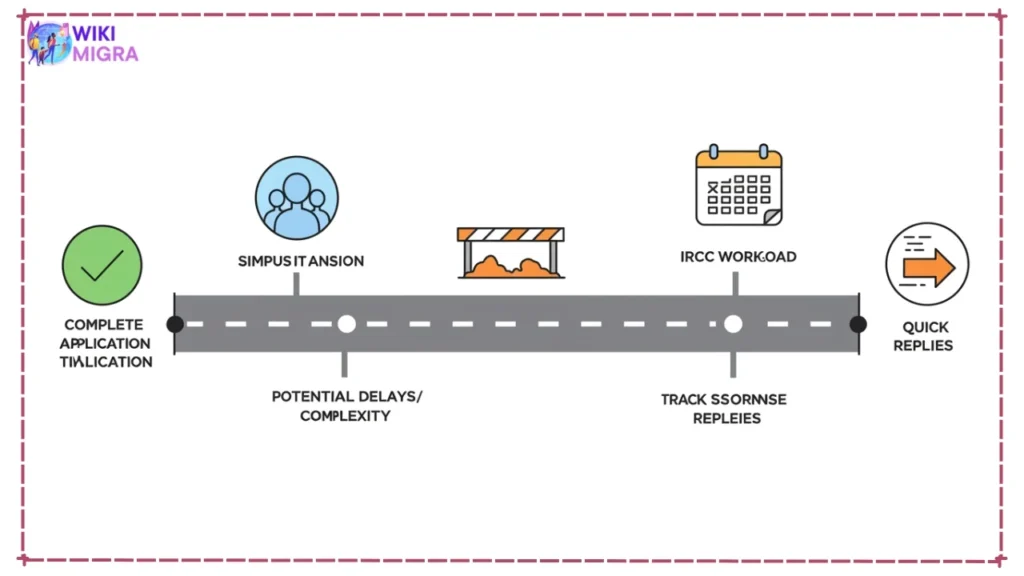
While the stages are sequential, several factors influence the overall inland spousal sponsorship processing time:
- Application Quality (The #1 Controllable Factor):
- Completeness: Missing documents, forms, or signatures will cause delays or return of the application. Double and triple-check everything.
- Accuracy: Ensure all information provided is truthful and consistent across all forms and documents. Misrepresentation can lead to refusal and a ban.
- Strong Evidence: Especially for relationship genuineness. Provide comprehensive proof covering different aspects of your life together (financial interdependence, cohabitation, social recognition, communication). Quality over quantity, but ensure sufficient breadth and depth.
- IRCC Current Workload & Backlogs:
- Processing offices have varying capacities and may face backlogs due to high application volumes, staff shortages, or global events impacting operations. This is largely outside your control but influences the general Canada inland sponsorship duration. Check IRCC news releases for updates on backlogs.
- Case Complexity:
- Previous Refusals: Prior visa or immigration application refusals may trigger extra scrutiny.
- Dependents: Including dependent children adds complexity and requires additional checks.
- Medical/Criminality Issues: Flags during medical exams or background checks require further assessment and can cause significant delays. Full disclosure upfront is crucial.
- Relationship Flags: Short relationship duration before marriage/cohabitation, significant age difference, cultural differences not well-explained, previous sponsorships – these might lead to requests for more evidence or even an interview.
- Responding Quickly to IRCC:
- If IRCC requests Additional Documents (ADRs) or clarification, respond promptly and thoroughly within the given deadline. Delays in your response directly delay your application.
- Applicant’s Country of Citizenship/Residence History:
- Security screening times can vary depending on the applicant’s countries of citizenship and residence over the past 10 years, as IRCC may need to coordinate with international partners.
- Applying Online:
- Since online submission via the PR portal is now mandatory for most, this standardizes intake. Using the portal correctly and ensuring uploaded documents are clear and properly formatted is essential.
How to Check Your Application Status
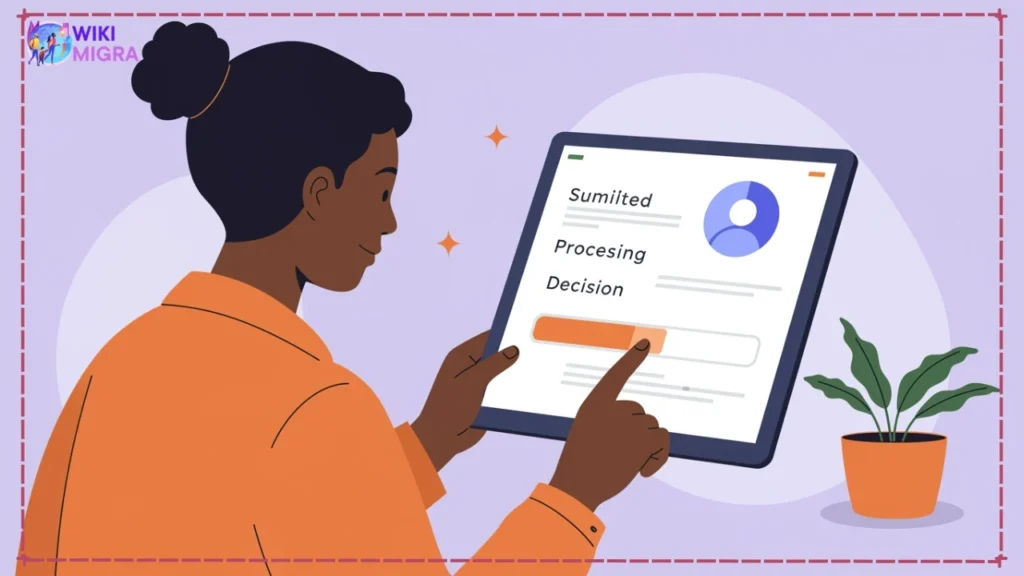
Staying informed (without obsessing!) is key. Here are the primary ways:
- Online Application Tracker (Permanent Residence Application Tracker): Once you have your AOR, IRCC often invites applicants to use this tracker. It provides stage-based updates (e.g., “Biometrics completed,” “Medical exam received,” “Background check in progress”).
- Linking Application to GCKey Account: You (or your representative) can link your submitted application to a secure IRCC account (GCKey or Sign-In Partner). This often provides more detailed status updates and allows you to receive messages directly from IRCC. This is highly recommended.
- IRCC Web Form: If your application is significantly delayed beyond the published average processing times for your specific stage, you can submit a case-specific inquiry via the IRCC web form. Use this sparingly, as excessive inquiries won’t speed up processing and can overload the system.
Managing Expectations and Dealing with Delays
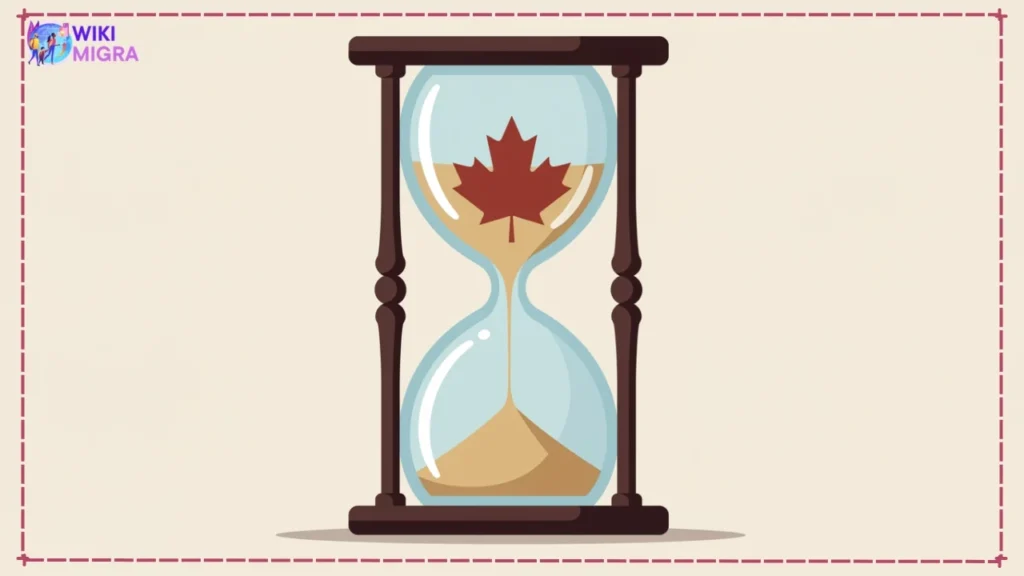
The wait time inland spousal sponsorship can be stressful. Here’s how to cope:
- Remember Averages are Averages: Your timeline will vary. Don’t panic if you see others approved faster or if you slightly exceed the average.
- Focus on Controllables: Ensure your application was as strong as possible. Respond instantly to any IRCC requests.
- Patience is Key: Processing takes time. Obsessively checking status daily won’t help. Set weekly or bi-weekly reminders if needed.
- Utilize the OWP: If eligible, the OWP allows the applicant to work and integrate, making the wait more productive and less stressful.
- When to Inquire: Generally, avoid web form inquiries unless your application has been static for many months and is significantly past the high end of the average processing time for the stage you appear to be in (check the PR Tracker). For example, if the average total time is 12 months, don’t inquire at month 7. Wait until perhaps month 14-15+ with no updates.
- Seek Support: Connect with online forums or community groups for shared experiences, but be wary of comparing timelines obsessively, as every case is unique.
Average Processing Time for Inland Spousal Sponsorship
To determine the average processing time for inland spousal sponsorship applications in Canada, it is essential to analyze the most recent data and authoritative sources. Inland spousal sponsorship refers to cases where the sponsor (a Canadian citizen or permanent resident) and the sponsored spouse or common-law partner are both residing together in Canada during the application process.
Step 1: Understanding Inland Sponsorship Processing Times
The processing time for inland spousal sponsorship applications depends on several factors, including:
- The completeness of the application.
- The volume of applications being processed by Immigration, Refugees and Citizenship Canada (IRCC).
- Whether additional documentation or interviews are required.
- The use of advanced analytics and streamlined measures by IRCC to expedite routine cases.
Step 2: Current Average Processing Time
Based on multiple authoritative sources:
- IRCC’s official guidance indicates that inland spousal sponsorship applications typically take approximately 12 months to process.1 This timeline includes all stages of the application, from submission to final decision.
- Recent updates from December 2023 confirm that IRCC has harmonized processing times for inland and outland sponsorships, maintaining an average timeline of 10–12 months for most inland cases.
- Additional insights from immigration consultants suggest that while most cases fall within this range, individual circumstances such as incomplete documentation or requests for further information can extend processing times up to 24 months in rare situations.
Step 3: Factors Influencing Processing Times
Several factors can affect how quickly an inland spousal sponsorship application is processed:
- Completeness of Application: Submitting a complete application with all required forms and supporting documents minimizes delays.
- Biometrics and Medical Exams: Promptly completing biometrics and medical exams after receiving requests from IRCC can prevent unnecessary holds on the application.
- Volume of Applications: High volumes of applications at specific visa offices may lead to longer wait times.
- Quebec-Specific Requirements: Applicants destined for Quebec must meet additional provincial requirements, which can add several months to the overall timeline.
The average processing time for inland spousal sponsorship applications in Canada is approximately 12 months. However, depending on individual circumstances, this timeframe may range from 10 months to up to 24 months in exceptional cases.
How Long to get AIP for Inland Sponsorship?
Approval in Principle (AIP) is a critical milestone in the inland spousal sponsorship process in Canada. It signifies that Immigration, Refugees, and Citizenship Canada (IRCC) has reviewed the application and determined that the sponsor meets eligibility requirements and that the relationship appears genuine. However, AIP does not guarantee final approval for permanent residency; it simply allows the application to proceed to the next stage.
Timeline for Receiving AIP
The timeline for receiving AIP depends on several factors, including the completeness of the application, IRCC’s workload, and whether additional documentation or interviews are required. Based on current information:
- Acknowledgment of Receipt (AOR):
After submitting an inland sponsorship application, IRCC typically takes 1 to 3 months to issue an Acknowledgment of Receipt (AOR). This step confirms that IRCC has received a complete application package. - Processing Time for AIP:
Once the AOR is issued, it generally takes 4 to 9 months for IRCC to assess the sponsor’s eligibility and evaluate the genuineness of the relationship. If approved at this stage, IRCC grants “Approval in Principle” (AIP).
In summary: It typically takes between 4 and 9 months after receiving an acknowledgment of receipt (AOR) from IRCC to obtain Approval in Principle (AIP) for inland spousal sponsorship applications.
Factors Affecting Processing Times
Several factors can influence how long it takes to receive AIP:
- Completeness of Application: Missing documents or incomplete forms can delay processing.
- Volume of Applications: High volumes of applications may extend processing times.
- Additional Requests: If IRCC requires more evidence or an interview to verify the relationship’s authenticity, this can add time.
- Medical Exams and Biometrics: These may be requested during this phase if they were not submitted earlier.
Total Estimated Timeline
For inland spousal sponsorship applications:
- The total time from submission to receiving AIP is approximately 5 to 12 months, depending on individual circumstances.
How long does the OWP take with inland sponsorship?
The processing time for an Open Work Permit (OWP) submitted alongside an Inland Spousal Sponsorship application is approximately 4 to 5 months. This timeline applies to applications submitted under the Spouse or Common-Law Partner in Canada Class, where the sponsored individual is already residing in Canada with their sponsor.
Step-by-Step Explanation of Processing Time
- Acknowledgment of Receipt (AOR):
- After submitting an Inland Spousal Sponsorship application, Immigration, Refugees and Citizenship Canada (IRCC) first issues an Acknowledgment of Receipt (AOR). This confirms that the permanent residence application has been received and is being processed.
- The AOR is a critical document because it is required for the OWP application. Typically, applicants receive the AOR within 4 to 5 weeks after submission of the sponsorship application.
- Open Work Permit Application Submission:
- Applicants can submit their OWP application either at the same time as their Inland Sponsorship application or after receiving their AOR. Submitting both applications together may help streamline processing times.
- Processing Time for OWP:
- IRCC aims to process new work permit applications, including those for spousal open work permits, within a service standard of 60 days.
- However, real-world data suggests that processing times for OWPs tied to Inland Sponsorships are closer to 4 to 5 months due to additional factors such as verification of documents and workload at IRCC offices.
- Factors Affecting Processing Times:
- The completeness of the application.
- Whether biometrics have been provided promptly.
- The volume of applications being processed by IRCC at any given time.
- Any additional documentation requests from IRCC.
Key Points About OWPs with Inland Sponsorship
- Eligibility Requirements: To qualify for an OWP under this program:
- The applicant must be in a genuine relationship with their sponsor.
- They must have valid temporary resident status in Canada (e.g., as a visitor, student, or worker).
- They must reside in Canada with their sponsor while awaiting permanent residence approval.
- Benefits of an OWP:
- An OWP allows sponsored individuals to work full-time anywhere in Canada while waiting for their permanent residence decision. This reduces financial strain and helps integrate them into Canadian society.
- Quebec-Specific Delays: If you are applying from Quebec, additional provincial requirements may extend overall processing times.
In summary, while IRCC officially targets a service standard of around two months for work permits, applicants under Inland Sponsorship should realistically expect a total processing time of about 4 to 5 months for their Open Work Permit.
Key Points About OWPs with Inland Sponsorship
- Eligibility Requirements: To qualify for an OWP under this program:
- The applicant must be in a genuine relationship with their sponsor.
- They must have valid temporary resident status in Canada (e.g., as a visitor, student, or worker).
- They must reside in Canada with their sponsor while awaiting permanent residence approval.
- Benefits of an OWP:
- An OWP allows sponsored individuals to work full-time anywhere in Canada while waiting for their permanent residence decision. This reduces financial strain and helps integrate them into Canadian society.
- Quebec-Specific Delays: If you are applying from Quebec, additional provincial requirements may extend overall processing times.
In summary, while IRCC officially targets a service standard of around two months for work permits, applicants under Inland Sponsorship should realistically expect a total processing time of about 4 to 5 months for their Open Work Permit.
Why is my inland sponsorship taking so long?
Your inland sponsorship application may be taking longer due to several factors, such as incomplete documentation, delays in medical or security screenings, high application volumes at IRCC, or the complexity of your case (e.g., proving relationship genuineness or addressing inadmissibility issues). Additionally, IRCC backlogs and operational disruptions can extend processing times beyond standard estimates.
Can you Track Inland Spousal Sponsorship Progress?
Yes, you can track the progress of an inland spousal sponsorship application. The Government of Canada provides several tools and methods for sponsors and applicants to monitor the status of their applications. Below is a detailed explanation of how you can track your inland spousal sponsorship application step by step.
Step 1: Acknowledgment of Receipt (AOR)
Before you can track your application, you must first receive an Acknowledgment of Receipt (AOR) letter or email from Immigration, Refugees and Citizenship Canada (IRCC). This document confirms that IRCC has received your application and deemed it complete for processing. The AOR contains crucial information such as:
- Your application number
- Your Unique Client Identifier (UCI)
If you have not yet received the AOR, it means IRCC has not started processing your application. Applications that are incomplete or missing fees will be returned without an AOR.
Step 2: Use the Application Status Tracker
Once you have received the AOR, you can use the Application Status Tracker provided by IRCC to check the progress of your inland spousal sponsorship application. Follow these steps:
- Create an Account in the Application Status Tracker
If this is your first time using the tracker, you need to create a new account. To register, you will need:- Your UCI or client ID
- Your application number
- Your first and last name
- Your date of birth
- Your place of birth
Representatives or designated persons will also need their Party ID.
- Sign In to Check Updates
After creating an account, sign in using your credentials to view updates about your application status. The tracker provides real-time updates on various stages such as:- Eligibility assessment
- Background checks
- Medical exams
- Final decision
- Access the tracker here: Application Status Tracker
Step 3: Link Paper Applications to an Online Account (if applicable)
If you submitted a paper-based inland spousal sponsorship application, you can link it to an online IRCC secure account for easier tracking. Here’s how:
- Gather all documents related to your application.
- Use details like your UCI and application number to link the paper file.
- Once linked, log in to view updates and messages about your case.
For more information on linking applications, visit IRCC’s instructions.
Step 4: Monitor Processing Times
While tracking progress, it’s helpful to understand typical processing times for inland spousal sponsorships:
- As of April 2025, IRCC estimates that most inland spousal sponsorship applications take approximately 12 months from submission to final decision.
- You can check updated processing times here: Check Processing Times.
Step 5: Additional Notifications During Processing
During processing, IRCC may request additional documents or steps from either the sponsor or applicant:
- Biometrics Collection: Applicants will receive a letter instructing them where and when to provide biometrics.
- Medical Exams: Applicants may be required to undergo medical examinations.
- Police Certificates: These may be requested depending on individual circumstances.
Ensure that all requests are fulfilled promptly within specified deadlines (e.g., biometrics must typically be submitted within 30 days).
Step 6: Use Third-Party Tools for Tracking Trends (Optional)
In addition to official tools provided by IRCC, some third-party platforms like MyImmiTracker allow users to share timelines and experiences with others undergoing similar processes. While these tools are unofficial, they provide insights into trends based on user-submitted data.
How Long Does Inland Sponsorship Take After Acknowledgment of Receipt (AOR)?
To determine how long inland spousal sponsorship takes after receiving the Acknowledgment of Receipt (AOR), it is essential to break down the process into its key stages and consider the factors that influence processing times. Inland spousal sponsorship applications are processed by Immigration, Refugees and Citizenship Canada (IRCC) in several steps, each with its own timeline.
1. Overview of the Process After Receiving AOR
The Acknowledgment of Receipt (AOR) is a critical milestone in the inland sponsorship process. It confirms that IRCC has received your application and deemed it complete enough to begin formal processing. Once you receive the AOR, the following stages occur:
- Sponsor Eligibility Assessment:
- IRCC assesses whether the sponsor meets eligibility criteria, such as being a Canadian citizen or permanent resident, meeting financial requirements, and not having been sponsored themselves within the last five years.
- This stage typically takes 6 to 12 months, depending on case complexity and IRCC’s workload.
- Open Work Permit (Optional):
- If the sponsored spouse applies for an Open Work Permit (OWP) along with their sponsorship application, they may receive it within 4 to 5 months after submitting their application.
- The OWP allows them to work in Canada while waiting for their permanent residence decision.
- Admissibility Assessment:
- After sponsor eligibility is confirmed, IRCC evaluates whether the sponsored person meets admissibility requirements. This includes:
- Medical examinations.
- Criminal background checks.
- Security screenings.
- This stage can take an additional 6 to 15 months, depending on factors such as country-specific background checks or requests for additional documentation.
- After sponsor eligibility is confirmed, IRCC evaluates whether the sponsored person meets admissibility requirements. This includes:
- Final Decision and Confirmation of Permanent Residence (COPR):
- Once all assessments are completed successfully, IRCC issues a final decision on the application.
- If approved:
- The sponsored individual receives a letter inviting them to meet with an immigration officer at a local office for finalization if they are already in Canada.
- They will be issued their Confirmation of Permanent Residence (COPR).
- Finalization typically occurs within 1 to 3 months after second-stage approval.
2. Typical Total Processing Time
After receiving the AOR, inland spousal sponsorship applications generally take between 12 to 27 months to process fully. However, this range depends on several factors:
- Completeness of the application: Missing documents or incomplete forms can lead to delays if IRCC requests additional information.
- Volume of applications: High volumes may result in backlogs at processing centers.
- Complexity of the case: Cases involving previous refusals, criminal records, or medical inadmissibility require more scrutiny.
- Country-specific background checks: Some countries require more extensive security screenings due to fraud risks or political instability.
For most straightforward cases where no additional documentation is requested and there are no complications, processing times tend toward the lower end of this range—approximately 12 to 16 months.
3. Factors That May Affect Processing Times
Several variables can influence how long it takes for inland spousal sponsorship applications to be processed after receiving AOR:
- Completeness of Application:
- Applications missing required documents or fees will face delays as IRCC must request these items before proceeding.
- IRCC Operational Capacity:
- Changes in staffing levels or increases in application volumes can slow down processing times.
- External Events:
- Global events like pandemics or technical issues with IRCC systems may cause unexpected delays.
- Complexity of Case:
- Applications involving legal issues, prior immigration history, or inadmissibility concerns often require additional investigation.
Inland spousal sponsorship applications typically take between 12 and 27 months after receiving an Acknowledgment of Receipt (AOR), with most straightforward cases being processed within 12 to 16 months if no complications arise. Sponsor eligibility assessment usually takes 6–12 months; admissibility checks add another 6–15 months; finalization occurs within 1–3 months thereafter.
Sources:
- Sponsor your spouse, partner or child: After you apply [Canada.ca]
- Inland Spousal Sponsorship Timeline [CanadaVisa Forum]
- Open Work Permit Processing Times [CanadaVisa Forum]
- Application Processing Timeline [Canadian Immigration Services]
Frequently Asked Questions (FAQ)
(Note: Implement FAQPage Schema markup in the webpage’s HTML for this section)
- Q: What is the fastest timeline for inland spousal sponsorship?
- A: There’s no guaranteed “fastest” timeline. While some straightforward cases processed during low-volume periods might finish closer to the lower end of the average (e.g., 6-8 months), aiming for speed shouldn’t compromise application quality. The best way to potentially expedite your case is by submitting an exceptionally well-prepared, complete, and convincing application from the start, minimizing the need for IRCC to request further information. Factors like IRCC workload remain outside your control.
- Q: Can I work while my inland application is processing?
- A: Yes, potentially. If you applied under the Spouse or Common-Law Partner in Canada (SCLPC) class and submitted an Open Work Permit (OWP) application concurrently with your PR application (or while your PR application is processing), you are likely eligible. Once the OWP is approved (often after AIP on the PR application), you can work for almost any employer in Canada. Check the OWP section above for more details and the specific IRCC tool for OWP processing times.
- Q: Does getting AIP (Approval in Principle) mean my application is approved?
- A: AIP means your application has passed the initial eligibility review – the officer believes the sponsor is eligible and the relationship appears genuine. It’s a very positive sign! However, it’s not the final approval. Final admissibility checks (security, criminality, medical review confirmation) must still be completed before a final decision is made and permanent residence is granted via COPR.
- Q: Why is my application taking longer than the average inland spousal sponsorship processing time?
- A: Several factors could cause delays beyond the average how long inland spousal sponsorship canada takes: complexities in your case (e.g., previous immigration issues, medical flags, needing extensive background checks due to residence history), IRCC requesting additional documents or clarification, high application volumes at the processing office handling your file, or specific security screening requirements taking longer than usual. Refer to the “Key Factors That Can Speed Up or Slow Down Your Timeline” section above.
- Q: What happens after I get my COPR inland?
- A: Once you receive your electronic Confirmation of Permanent Residence (e-COPR) through the IRCC portal (virtual landing), you are officially a Permanent Resident of Canada! Your physical PR card will be mailed to your Canadian address within several weeks. You should then apply for your provincial health card and update your Social Insurance Number (SIN) from temporary to permanent status.
Conclusion
Navigating the Canada inland spousal sponsorship timeline requires patience, diligence, and a clear understanding of the process. While the average inland spousal sponsorship processing time provides a benchmark (currently around 8-12 months for 2025 estimates), remember that individual experiences vary widely.
The most crucial steps within your control are preparing a meticulous, complete, and convincing application package and responding promptly to any communication from IRCC. Understanding the different stages—from AOR and biometrics to the critical eligibility review, AIP, and potential OWP issuance—helps manage expectations during the length of the inland spousal sponsorship process.
Stay informed using the official IRCC tools, but avoid unnecessary anxiety by constantly comparing your timeline to others. Focus on building your life together in Canada; the confirmation of permanent residence is a significant milestone worth the wait. We wish you the very best on this important journey towards family reunification in Canada!





